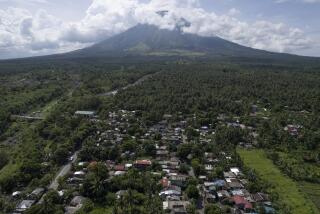Superheated Debris a Peril at Philippine Volcano
- Share via
The latest eruption Friday of the Mayon volcano in the Philippines--with reports of superheated debris, known as pyroclastic flows, reaching down the slopes three miles from the crater--struck volcanologists on the scene and in the United States as ominous.
Although 42,000 people have been evacuated from a “permanent exclusion zone” within four miles of the mountain since the eruption there last week that killed 68 people, Philippine authorities reported that at least 50 others were refusing to leave the zone.
Scientists warn that in case of a major eruption, there might be no time to leave. Temperatures as high as 1,800 degrees Fahrenheit were reported in the flow Friday.
It was a similar, if larger, glowing cloud of molten lava and gases that surged four miles down from the summit of Mt. Pelee at about 150 m.p.h. on May 8, 1902, broadsiding St. Pierre on the Caribbean island of Martinique, killing 29,933.
Mt. Mayon, 7,943 feet high and 200 miles southeast of Manila, has not caused such a catastrophe. But it is a dangerous volcano. It has erupted 47 times since the 17th Century, causing deaths in 12 of those eruptions. In 1814, a mudflow killed 1,200 people, and there have been numerous pyroclastic flows.
Legazpi, population 150,000, is only 10 miles from the volcano.
Raymundo Punongbayan, director of the Philippine Institute of Volcanology and Seismology, called Friday’s eruption “moderate,” but warned that bigger explosions are probable.
“They may occur quickly,” said David Harlow, a volcanologist from the U.S. Geological Survey in Menlo Park, Calif., in an interview. “These flows are real killers, because you just cannot get out of the way fast enough, and wherever we see geologic evidence of those we are very concerned.”
Bob Tilling, another Geological Survey scientist, explained, “The basic difference between a lava flow and a pyroclastic flow is the gas content. Because of the high gas content, they (pyroclastic flows) are very fluid and mobile and can move at high speed over topographic barriers or ridges.”
At Mt. Pelee, there had been only minor eruptions in the 250 years since European colonization, and authorities believed that, at most, there would be lava flows that would be deflected by canyons between the summit and the town. But the pyroclastic cloud skipped along the top of the terrain and reached the town in two minutes.
At Mt. Mayon, the exclusion zone was ordered after a 1984 eruption. But in the quiet period since, it had been allowed to lapse.
Chuck Connor of the Southwest Research Institute at San Antonio said, “My understanding is that a lot of farming was going on on the slopes, even on the 1984 pyroclastic flows. That’s a really dismal kind of situation, but volcanoes are very fertile and someone in the subsistence farming business is easily attracted.”
More to Read
Sign up for Essential California
The most important California stories and recommendations in your inbox every morning.
You may occasionally receive promotional content from the Los Angeles Times.













